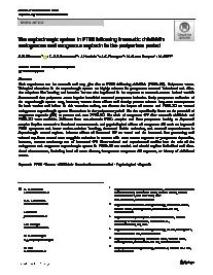The oxytocinergic system in PTSD following traumatic childbirth : endogenous and exogenous oxytocin in the peripartum period
Birth experiences can be traumatic and may give rise to PTSD following childbirth (PTSD-FC). Peripartum neurobiological alterations in the oxytocinergic system are highly relevant for postpartum maternal behavioral and affective adaptions like bonding and lactation but are also implicated in the response to traumatic events. Animal models demonstrated that peripartum stress impairs beneficial maternal postpartum behavior. Early postpartum activation of the oxytocinergic system may, however, reverse these effects and thereby prevent adverse long-term consequences for both mother and infant. In this narrative review, we discuss the impact of trauma and PTSD-FC on normal endogenous oxytocinergic system fluctuations in the peripartum period. We also specifically focus on the potential of exogenous oxytocin (OT) to prevent and treat PTSD-FC. No trials of exogenous OT after traumatic childbirth and PTSD-FC were available. Evidence from non-obstetric PTSD samples and from postpartum healthy or depressed samples implies restorative functional neuroanatomic and psychological effects of exogenous OT such as improved PTSD symptoms and better mother-to-infant bonding, decreased limbic activation, and restored responsiveness in dopaminergic reward regions. Adverse effects of intranasal OT on mood and the increased fear processing and reduced top-down control over amygdala activation in women with acute trauma exposure or postpartum depression, however, warrant cautionary use of intranasal OT. Observational and experimental studies into the role of the endogenous and exogenous oxytocinergic system in PTSD-FC are needed and should explore individual and situational circumstances, including level of acute distress, intrapartum exogenous OT exposure, or history of childhood trauma.
Geachte bezoeker,
De informatie die u nu opvraagt, kan door psychotraumanet niet aan u worden getoond. Dit kan verschillende redenen hebben,
waarvan (bescherming van het) auteursrecht de meeste voorkomende is. Wanneer het mogelijk is om u door te verwijzen naar de bron
van deze informatie, dan ziet u hier onder een link naar die plek.
Als er geen link staat, kunt u contact opnemen met de bibliotheek,
die u verder op weg kan helpen.
Met vriendelijke groet,
Het psychotraumanet-team.
In: Archives of Women's Mental Health ; ISSN : 1435-1102
https://link.springer.com/article/10.1007%2Fs00737-019-00994-0


